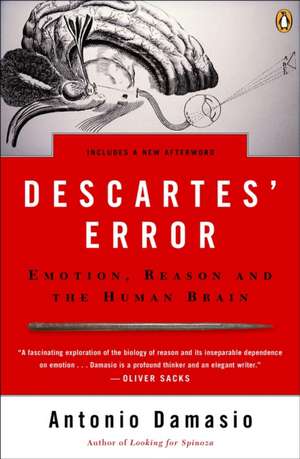Descartes' Error: Emotion, Reason, and the Human Brain
Autor Antonio R. Damasioen Limba Engleză Paperback – 31 aug 2005 – vârsta de la 18 ani
Since Descartes famously proclaimed, "I think, therefore I am," science has often overlooked emotions as the source of a person’s true being. Even modern neuroscience has tended, until recently, to concentrate on the cognitive aspects of brain function, disregarding emotions. This attitude began to change with the publication of Descartes’ Error in 1995. Antonio Damasio—"one of the world’s leading neurologists" (The New York Times)—challenged traditional ideas about the connection between emotions and rationality. In this wondrously engaging book, Damasio takes the reader on a journey of scientific discovery through a series of case studies, demonstrating what many of us have long suspected: emotions are not a luxury, they are essential to rational thinking and to normal social behavior.
Preț: 100.44 lei
Nou
Puncte Express: 151
Preț estimativ în valută:
19.22€ • 20.11$ • 15.97£
19.22€ • 20.11$ • 15.97£
Carte disponibilă
Livrare economică 12-26 martie
Preluare comenzi: 021 569.72.76
Specificații
ISBN-13: 9780143036227
ISBN-10: 014303622X
Pagini: 312
Ilustrații: b/w illustrations throughout
Dimensiuni: 129 x 197 x 15 mm
Greutate: 0.23 kg
Editura: Penguin Books
ISBN-10: 014303622X
Pagini: 312
Ilustrații: b/w illustrations throughout
Dimensiuni: 129 x 197 x 15 mm
Greutate: 0.23 kg
Editura: Penguin Books
Cuprins
Introduction xi
PART I
Unpleasantness in Vermont 3
Gage's Brain Revealed 20
A Modern Phineas Gage 34
In Colder Blood 52
PART II
Assembling an Explanation 83
Biological Regulation and Survival 114
Emotions and Feelings 127
The Somatic-Marker Hypothesis 165
PART III
Testing the Somatic-Marker Hypothesis 205
The Body-Minded Brain 223
A Passion for Reasoning 245
Postscriptum 253
Notes and References 269
Further Reading 293
Acknowledgments 299
Index 301
PART I
Unpleasantness in Vermont 3
Gage's Brain Revealed 20
A Modern Phineas Gage 34
In Colder Blood 52
PART II
Assembling an Explanation 83
Biological Regulation and Survival 114
Emotions and Feelings 127
The Somatic-Marker Hypothesis 165
PART III
Testing the Somatic-Marker Hypothesis 205
The Body-Minded Brain 223
A Passion for Reasoning 245
Postscriptum 253
Notes and References 269
Further Reading 293
Acknowledgments 299
Index 301
Recenzii
Introduction xi
PART I
Unpleasantness in Vermont 3
Gage's Brain Revealed 20
A Modern Phineas Gage 34
In Colder Blood 52
PART II
Assembling an Explanation 83
Biological Regulation and Survival 114
Emotions and Feelings 127
The Somatic-Marker Hypothesis 165
PART III
Testing the Somatic-Marker Hypothesis 205
The Body-Minded Brain 223
A Passion for Reasoning 245
Postscriptum 253
Notes and References 269
Further Reading 293
Acknowledgments 299
Index 301
PART I
Unpleasantness in Vermont 3
Gage's Brain Revealed 20
A Modern Phineas Gage 34
In Colder Blood 52
PART II
Assembling an Explanation 83
Biological Regulation and Survival 114
Emotions and Feelings 127
The Somatic-Marker Hypothesis 165
PART III
Testing the Somatic-Marker Hypothesis 205
The Body-Minded Brain 223
A Passion for Reasoning 245
Postscriptum 253
Notes and References 269
Further Reading 293
Acknowledgments 299
Index 301
Notă biografică
Antonio Damasio, a neurologist and neuroscientist, is at the University of Southern California, where he directs a new brain research institute dedicated to the study of emotion and creativity. He is also an adjunct professor at the Salk Institute. The recipient of numerous awards (several shared with his wife Hanna Damasio, also a neurologist and neuroscientist), he is a member of the Institute of Medicine of the National Academy of Sciences and a fellow of the American Academy of Arts and Sciences. He is the author of two other widely acclaimed books, The Feeling of What Happens and Looking for Spinoza.
Extras
Chapter One: Unpleasantness in Vermont Phineas P. Gage
It is the summer of 1848. We are in New England. Phineas P Gage, twenty-five years old, construction foreman, is about to go from riches to rags. A century and a half later his downfall will still be quite meaningful.
Gage works for the Rutland &Burlington Railroad and is in charge of a large group of men, a "gang" as it is called, whose job it is to lay down the new tracks for the railroad's expansion across Vermont. Over the past two weeks the men have worked their way slowly toward the town of Cavendish; they are now at a bank of the Black River. The assignment is anything but easy because of the outcrops of hard rock. Rather than twist and turn the tracks around every escarpment, the strategy is to blast the stone and make way for a straighter and more level path. Gage oversees these tasks and is equal to them in every way. He is five-foot-six and athletic, and his movements are swift and precise. He looks like a young Jimmy Cagney, a Yankee Doodle dandy dancing his tap shoes over ties and tracks, moving with vigor and grace.
In the eyes of his bosses, however, Gage is more than just another able body. They say he is "the most efficient and capable" man in their employ.- This is a good thing, because the job takes as much physical prowess as keen concentration, especially when it comes to preparing the detonations. Several steps have to be followed, in orderly fashion. First, a hole must be drilled in the rock. After it is filled about halfway with explosive powder, a fuse must be inserted, and the powder covered with sand. Then the sand must be "tampedin," or pounded with a careful sequence of strokes from an iron rod. Finally, the fuse must be lit. If all goes well, the powder will explode into the rock; the sand is essential, for without its protection the explosion would be directed away from the rock. The shape of the iron and the way it is played are also important. Gage, who has had an iron manufactured to his specifications, is a virtuoso of this thing.
Now for what is going to happen. It is four-thirty on this hot afternoon. Gage has just put powder and fuse in a hole and told the man who is helping him to cover it with sand. Someone calls from behind, and Gage looks away, over his right shoulder, for only an instant. Distracted, and before his man has poured the sand in, Gage begins tamping the powder directly with the iron bar. In no time he strikes fire in the rock, and the charge blows upward in his face.
The explosion is so brutal that the entire gang freezes on their feet. It takes a few seconds to piece together what is going on. The bang is unusual, and the rock is intact. Also unusual is the whistling sound, as of a rocket hurled at the sky. But this is more than fireworks. It is assault and battery. The iron enters Gage's left cheek, pierces the base of the skull, traverses the front of his brain, and exits at high speed through the top of the head. The rod has landed more than a hundred feet away, covered in blood and brains. Phineas Gage has been thrown to the ground. He is stunned, in the afternoon glow, silent but awake. So are we all, helpless spectators.
"Horrible Accident" will be the predictable headline in the Boston Daily Courier and Daily Journal of September 20, a week later. "Wonderful Accident" will be the strange headline in the Vermont Mercury of September 22. "Passage of an Iron Rod Through the Head" will be the accurate headline in the Boston Medical and Surgical Journal. From the matter-of-factness with which they tell the story, one would think the writers were familiar with Edgar Allan Poe's accounts of the bizarre and the horrific. And perhaps they were, although this is not likely; Poe's gothic tales are not yet popular, and Poe himself will die the next year, unknown and impecunious. Perhaps the horrible is just in the air.
Noting how surprised people were that Gage was not killed instantly, the Boston medical article documents that "immediately after the explosion the patient was thrown upon his back"; that shortly thereafter he exhibited "a few convulsive motions of the extremities," and "spoke in a few minutes"; that "his men (with whom he was a great favourite) took him in their arms and carried him to the road, only a few rods distant (a rod is equivalent to 5 1/2 yards, or 16 1/2 feet), and sat him into an ox cart, in which he rode, sitting erect, a full three quarters of a mile, to the hotel of Mr. Joseph Adams"; and that Gage "got out of the cart himself, with a little assistance from his men."
Let me introduce Mr. Adams. He is the justice of the peace for Cavendish and the owner of the town's hotel and tavern. He is taller than Gage, twice as round, and as solicitous as his Falstaff shape suggests. He approaches Gage, and immediately has someone call for Dr. John Harlow, one of the town physicians. While they wait, I imagine, he says, "Come, come, Mr. Gage, what have we got here?" and, why not, "My, my, what troubles we've seen." He shakes his head in disbelief and leads Gage to the shady part of the hotel porch, which has been described as a "piazza." That makes it sound grand and spacious and open, and perhaps it is grand and spacious, but it is not open; it is just a porch. And there perhaps Mr. Adams is now giving Phineas Gage lemonade, or maybe cold cider.
An hour has passed since the explosion. The sun is declining and the heat is more bearable.
It is the summer of 1848. We are in New England. Phineas P Gage, twenty-five years old, construction foreman, is about to go from riches to rags. A century and a half later his downfall will still be quite meaningful.
Gage works for the Rutland &Burlington Railroad and is in charge of a large group of men, a "gang" as it is called, whose job it is to lay down the new tracks for the railroad's expansion across Vermont. Over the past two weeks the men have worked their way slowly toward the town of Cavendish; they are now at a bank of the Black River. The assignment is anything but easy because of the outcrops of hard rock. Rather than twist and turn the tracks around every escarpment, the strategy is to blast the stone and make way for a straighter and more level path. Gage oversees these tasks and is equal to them in every way. He is five-foot-six and athletic, and his movements are swift and precise. He looks like a young Jimmy Cagney, a Yankee Doodle dandy dancing his tap shoes over ties and tracks, moving with vigor and grace.
In the eyes of his bosses, however, Gage is more than just another able body. They say he is "the most efficient and capable" man in their employ.- This is a good thing, because the job takes as much physical prowess as keen concentration, especially when it comes to preparing the detonations. Several steps have to be followed, in orderly fashion. First, a hole must be drilled in the rock. After it is filled about halfway with explosive powder, a fuse must be inserted, and the powder covered with sand. Then the sand must be "tampedin," or pounded with a careful sequence of strokes from an iron rod. Finally, the fuse must be lit. If all goes well, the powder will explode into the rock; the sand is essential, for without its protection the explosion would be directed away from the rock. The shape of the iron and the way it is played are also important. Gage, who has had an iron manufactured to his specifications, is a virtuoso of this thing.
Now for what is going to happen. It is four-thirty on this hot afternoon. Gage has just put powder and fuse in a hole and told the man who is helping him to cover it with sand. Someone calls from behind, and Gage looks away, over his right shoulder, for only an instant. Distracted, and before his man has poured the sand in, Gage begins tamping the powder directly with the iron bar. In no time he strikes fire in the rock, and the charge blows upward in his face.
The explosion is so brutal that the entire gang freezes on their feet. It takes a few seconds to piece together what is going on. The bang is unusual, and the rock is intact. Also unusual is the whistling sound, as of a rocket hurled at the sky. But this is more than fireworks. It is assault and battery. The iron enters Gage's left cheek, pierces the base of the skull, traverses the front of his brain, and exits at high speed through the top of the head. The rod has landed more than a hundred feet away, covered in blood and brains. Phineas Gage has been thrown to the ground. He is stunned, in the afternoon glow, silent but awake. So are we all, helpless spectators.
"Horrible Accident" will be the predictable headline in the Boston Daily Courier and Daily Journal of September 20, a week later. "Wonderful Accident" will be the strange headline in the Vermont Mercury of September 22. "Passage of an Iron Rod Through the Head" will be the accurate headline in the Boston Medical and Surgical Journal. From the matter-of-factness with which they tell the story, one would think the writers were familiar with Edgar Allan Poe's accounts of the bizarre and the horrific. And perhaps they were, although this is not likely; Poe's gothic tales are not yet popular, and Poe himself will die the next year, unknown and impecunious. Perhaps the horrible is just in the air.
Noting how surprised people were that Gage was not killed instantly, the Boston medical article documents that "immediately after the explosion the patient was thrown upon his back"; that shortly thereafter he exhibited "a few convulsive motions of the extremities," and "spoke in a few minutes"; that "his men (with whom he was a great favourite) took him in their arms and carried him to the road, only a few rods distant (a rod is equivalent to 5 1/2 yards, or 16 1/2 feet), and sat him into an ox cart, in which he rode, sitting erect, a full three quarters of a mile, to the hotel of Mr. Joseph Adams"; and that Gage "got out of the cart himself, with a little assistance from his men."
Let me introduce Mr. Adams. He is the justice of the peace for Cavendish and the owner of the town's hotel and tavern. He is taller than Gage, twice as round, and as solicitous as his Falstaff shape suggests. He approaches Gage, and immediately has someone call for Dr. John Harlow, one of the town physicians. While they wait, I imagine, he says, "Come, come, Mr. Gage, what have we got here?" and, why not, "My, my, what troubles we've seen." He shakes his head in disbelief and leads Gage to the shady part of the hotel porch, which has been described as a "piazza." That makes it sound grand and spacious and open, and perhaps it is grand and spacious, but it is not open; it is just a porch. And there perhaps Mr. Adams is now giving Phineas Gage lemonade, or maybe cold cider.
An hour has passed since the explosion. The sun is declining and the heat is more bearable.
Textul de pe ultima copertă
"Although I cannot tell for certain what sparked my interest in the neural underpinnings of reason, I do know when I became convinced that the traditional views on the nature of rationality could not be correct". Thus begins a book that takes the reader on a journey of discovery, from the story of Phineas Gage, the famous nineteenth-century case of behavioral change that followed brain damage, to the contemporary recreation of Gage's brain; and from the doubts of a young neurologist to a testable hypothesis concerning the emotions and their fundamental role in rational human behavior. Drawing on his experiences with neurological patients affected by brain damage (his laboratory is recognized worldwide as the foremost center for the study of such patients), Antonio Damasio shows how the absence of emotion and feeling can break down rationality. In the course of explaining how emotions and feelings contribute to reason and to adaptive social behavior, Damasio also offers a novel perspective on what emotions and feelings actually are: a direct sensing of our own body states, a link between the body and its survival-oriented regulations, on the one hand, and consciousness, on the other. Descartes' Error leads us to conclude that human organisms are endowed from the very beginning with a spirited passion for making choices, which the social mind can use to build rational behavior.
Descriere
A great scientist presents a radical new conception of how our minds work, arguing that rational decisions are not the product of logic alone, but require the support of emotion and feeling.

























